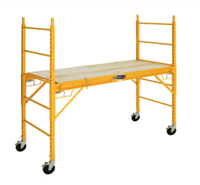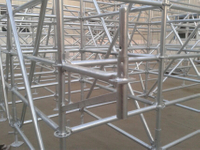Content Menu
● What is Mason Frame Scaffolding?
>> Key Features of Mason Frame Scaffolding
● What is Ladder Frame Scaffolding?
>> Key Features of Ladder Frame Scaffolding
● Structural Differences
● Functionality and Use
>> Mason Frame Scaffolding
>> Ladder Frame Scaffolding
● Assembly and Components
>> Mason Frame Scaffolding Assembly
>> Ladder Frame Scaffolding Assembly
● Safety Considerations
>> Mason Frame Scaffolding
>> Ladder Frame Scaffolding
● When to Use Each Type
>> Choose Mason Frame Scaffolding When:
>> Choose Ladder Frame Scaffolding When:
● Customization and Accessories
● Summary Table: Mason Frame vs. Ladder Frame Scaffolding
● Case Study: Selecting the Right Scaffolding for a Masonry Project
● Advanced Safety and Usage Tips
● Conclusion
● FAQ
>> 1. What is the main difference between mason frame scaffolding and ladder frame scaffolding?
>> 2. Can mason frame scaffolding be used for non-masonry projects?
>> 3. Are the rungs on mason frame scaffolding safe to climb?
>> 4. Which scaffolding type is better for narrow or indoor spaces?
>> 5. How do I ensure safety when using either scaffolding type?
Scaffolding is a critical component in construction, renovation, and maintenance projects. Among the various types, mason frame scaffolding and ladder frame scaffolding are two of the most widely used systems. While they may appear similar at first glance, their design, features, and ideal applications differ significantly.
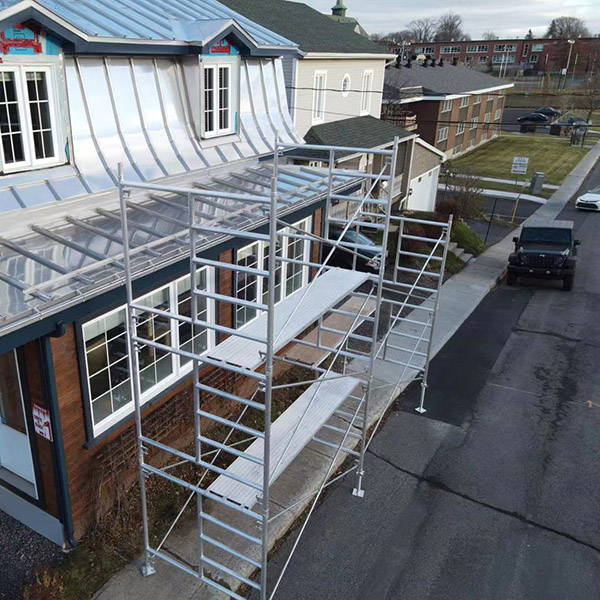
What is Mason Frame Scaffolding?
Mason frame scaffolding, also called “step frame” or “bricklayer's scaffolding,” is specifically designed for masonry work and other heavy-duty construction tasks. Its robust build and wide working platform make it ideal for supporting bricklayers, masons, and their materials.
Key Features of Mason Frame Scaffolding
- Frame Shape: Rectangular, with horizontal “steps” or rungs on one side. These rungs are not for climbing, but for supporting planks as makeshift workbenches when working in multi-tier setups.
- Size: Commonly 5 ft. wide x 6 ft. 4 in. high x 7 ft. long, but available in various sizes.
- Frame Leg Diameter: Typically 1.69" OD (outer diameter).
- Lock Span: Usually 4' (48"), allowing for secure cross brace attachment.
- Finish: Powder-coated (often blue) or galvanized for weather resistance and durability.
- Weight Capacity: Can support loads up to 4,900 lbs or more, suitable for heavy masonry materials.
- Accessories: Uses coupling pins, spring clips, cross braces, and can be mounted on leveling jacks or casters.
- Walk-Thru Option: Walk-thru mason frames allow easy movement along the length of the scaffold, even for wheelbarrows or large tools.
What is Ladder Frame Scaffolding?
Ladder frame scaffolding is a modular system featuring frames with integrated ladder rungs. It is designed for general construction, maintenance, and renovation projects, offering easy access between levels.
Key Features of Ladder Frame Scaffolding
- Frame Shape: Vertical frames with ladder-like rungs welded or bolted between two vertical poles.
- Types: Single ladder frame, double ladder frame, walk-through ladder frame, and more.
- Size: Available in various widths and heights, such as 42" or 5' wide and heights from 3' to 6'4".
- Accessibility: Ladder rungs allow workers to climb between levels without external ladders.
- Finish: Often galvanized or powder-coated for durability.
- Weight Capacity: Suitable for most construction tasks, but typically less than mason frame scaffolding.
- Accessories: Can be customized with guardrails, toe boards, ladder gates, and more.
- Versatility: Used for masonry, building, and general construction, and can save access ladders in assembly.
Structural Differences
| Feature | Mason Frame Scaffolding | Ladder Frame Scaffolding |
| Frame Design | Rectangular with horizontal steps/rungs (not for climbing) | Vertical with integrated ladder rungs (for climbing) |
| Width | Typically 5' wide for ample workspace | 2'–5' wide, often narrower options |
| Height | Commonly 6'4" tall, stackable | 3'–6'4" tall, stackable |
| Rungs | Not for climbing; used for planks/workbenches | Used for climbing between scaffold levels |
| Walk-Through Option | Available (walk-thru mason frames) | Available (walk-thru ladder frames) |
| Load Capacity | High (up to 4,900 lbs or more) | Moderate to high, depending on design |
| Primary Use | Masonry, bricklaying, heavy-duty tasks | General construction, maintenance |
Functionality and Use
Mason Frame Scaffolding
- Designed for bricklayers and masons: The wide platform accommodates workers, bricks, mortar, and tools.
- Horizontal steps/rungs: These are not for climbing but for resting planks to create workbenches or support materials at different heights.
- Walk-thru versions: Allow easy movement along the length of the scaffold, even for wheelbarrows or large tools.
- Heavy-duty: Built to support substantial weight and withstand the rigors of masonry work.
- Stackability: Frames are stackable and compatible with standard 5' wide staging.
- Long-span capability: The robust design allows for longer spans between frames, reducing the number of supports needed and increasing workspace efficiency.
Ladder Frame Scaffolding
- Integrated ladder rungs: Provide built-in access to higher or lower levels, eliminating the need for separate ladders.
- Versatile: Used in painting, plastering, maintenance, and lighter construction tasks.
- Narrower options: Suitable for tight spaces, interiors, or projects where a wide platform is not required.
- Ease of assembly: Lightweight and modular, often preferred for smaller or mobile jobs.
- Safety features: Can be equipped with guardrails, toe boards, and locking mechanisms for planks.
- Adaptability: Ladder frames can be used in combination with mobile towers or rolling scaffolds for projects that require frequent repositioning.
Assembly and Components
Mason Frame Scaffolding Assembly
- Frames are set upright and connected with cross braces for stability.
- Coupling pins and spring clips secure stacked frames.
- Planks or platforms are placed across frames to create the working surface.
- Base accessories: Leveling jacks or casters can be used for stability and mobility.
- Walk-thru or step frames: Choose based on whether you need open access or bench support.
- Safer stacking: Some mason frames use up to 30% less stacking space for storage.
- Heavy-duty cross braces: Designed to resist lateral movement and keep the structure rigid under heavy loads.
Ladder Frame Scaffolding Assembly
- Frames are positioned upright and connected with cross braces.
- Ladder rungs are used for climbing during assembly and use.
- Platforms are placed on horizontal ledgers or directly on frame supports.
- Can be customized: Add guardrails, toe boards, and gates for safety.
- Modular design: Allows for stacking and configuring to various heights and lengths.
- Locking mechanisms: Secure planks to prevent slippage and ensure stability.
- Quick assembly: Lightweight frames and tool-free connections speed up setup, especially for maintenance or short-term projects.
Safety Considerations
Mason Frame Scaffolding
- High load rating: Designed to support heavy materials and multiple workers.
- Non-climbable rungs: Steps are not for climbing-using them as such is unsafe.
- Guardrails and toe boards: Should be installed on all open sides for fall protection.
- Stability: Wide base and heavy-duty construction enhance stability, especially for masonry work.
- Weather resistance: Powder-coated or galvanized finish protects against harsh conditions.
- Inspection: Regularly check for bent frames, cracked welds, or damaged braces, especially after moving or heavy use.
Ladder Frame Scaffolding
- Climbable rungs: Rungs are spaced for safe climbing, but always climb from inside the frame.
- Guardrails and toe boards: Required for safety, especially at heights.
- Load limits: Generally lower than mason frames; do not overload platforms.
- Inspection: Regularly check welds, rungs, and locking mechanisms for wear or damage.
- Versatility: Adjustable height and width, but minimum platform width should not be less than 20 inches for safety.
- Proper use: Only one person should climb a ladder frame at a time, and always maintain three points of contact.
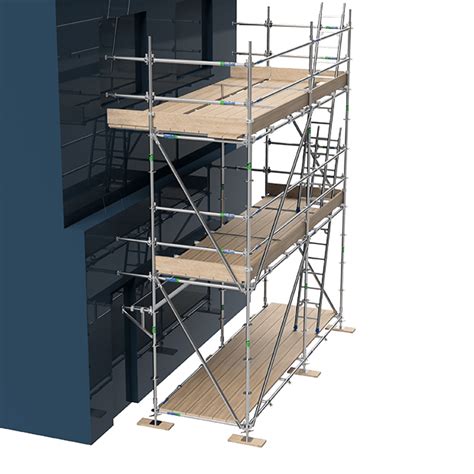
When to Use Each Type
Choose Mason Frame Scaffolding When:
- Your project involves masonry, bricklaying, or heavy-duty construction.
- You need a wide platform for multiple workers and materials.
- Stability and high load capacity are essential.
- You require walk-through access for moving materials or equipment along the scaffold.
- The worksite is outdoors or exposed to the elements, requiring extra durability.
Choose Ladder Frame Scaffolding When:
- You need built-in access between levels for painting, plastering, or light construction.
- The workspace is narrow or restricted.
- The project requires frequent repositioning or mobility.
- Lower weight capacity is sufficient for your tasks.
- You want a system that saves the need for additional ladders in assembly.
- The job is indoors or in a space with limited maneuvering room.
Customization and Accessories
Both mason frame scaffolding and ladder frame scaffolding can be customized:
- Platforms: Adjust width and length to fit specific needs.
- Guardrails, toe boards, and gates: Enhance safety and compliance.
- Surface finish: Powder-coated or galvanized for durability and weather resistance.
- Material choice: Steel for strength, aluminum for lighter weight and mobility.
- Lock types: Fast lock, flip lock, or Canada lock for different assembly preferences.
- Outriggers and base jacks: For additional stability, especially on uneven ground or for tall towers.
Summary Table: Mason Frame vs. Ladder Frame Scaffolding
| Attribute | Mason Frame Scaffolding | Ladder Frame Scaffolding |
| Frame Design | Rectangular, step/rung side | Ladder-like rungs on frame |
| Rungs Purpose | Plank support (not for climbing) | Climbing between levels |
| Common Width | 5' wide | 2'–5' wide |
| Common Height | 6'4" tall | 3'–6'4" tall |
| Load Capacity | Up to 4,900 lbs or more | Moderate to high |
| Primary Use | Masonry, bricklaying | General construction, maintenance |
| Walk-Through Option | Yes | Yes |
| Platform Space | Wide, suitable for materials | Narrower, for personnel |
| Assembly | Coupling pins, cross braces | Ladder rungs, cross braces |
| Safety | High, robust, non-climb rungs | Climbable, lighter-duty |
| Typical Accessories | Heavy-duty planks, mud sills, adjustable jacks | Guardrails, toe boards, mobile casters |
Case Study: Selecting the Right Scaffolding for a Masonry Project
A contractor working on a multi-story brick façade chose mason frame scaffolding for several reasons:
- Wide working platforms allowed masons to move freely and store bricks and mortar.
- High load capacity supported heavy materials and multiple workers.
- Walk-thru frames enabled easy movement of wheelbarrows and equipment along the scaffold.
- Powder-coated finish provided weather resistance for an outdoor, long-term project.
- Heavy-duty cross braces ensured the structure remained rigid and secure under load.
For an interior painting project in a narrow hallway, the same contractor switched to ladder frame scaffolding:
- Narrow frames fit easily in tight spaces.
- Integrated ladder rungs allowed workers to climb safely without extra ladders.
- Lightweight design made assembly and repositioning quick and easy.
- Mobile base with casters allowed the scaffold to be rolled from room to room without disassembly.
Advanced Safety and Usage Tips
For Mason Frame Scaffolding:
- Always use the steps/rungs only for supporting planks or benches, never for climbing.
- Regularly inspect the powder coating or galvanization for chips or rust, especially in outdoor use.
- Install guardrails and toe boards at every working level to prevent falls and dropped materials.
- Use leveling jacks or mud sills on uneven ground to ensure stability.
- Never exceed the manufacturer's specified load capacity, and distribute loads evenly across the platform.
For Ladder Frame Scaffolding:
- Ensure all rungs are securely welded and free from cracks or damage.
- Use locking mechanisms to secure planks and prevent slippage.
- Never exceed the rated load capacity; check manufacturer load charts.
- Use personal fall arrest systems or guardrails for work above 10 feet.
- Train all users in safe climbing techniques and scaffold assembly.
- When moving mobile ladder frame scaffolding, always clear the platform and ensure all wheels are locked before climbing.
Conclusion
Mason frame scaffolding and ladder frame scaffolding each have distinct advantages and are suited to different construction needs. Mason frame scaffolding is the go-to choice for masonry and heavy-duty applications, offering wide platforms, robust construction, and high load capacity. Its steps are for workbench support, not for climbing, and it excels in projects requiring stability and space for materials. Ladder frame scaffolding, with its integrated climbable rungs, excels in general construction, maintenance, and situations where built-in access and flexibility are required, especially in narrow or indoor environments. Understanding these differences ensures you select the safest, most efficient scaffolding system for your project.
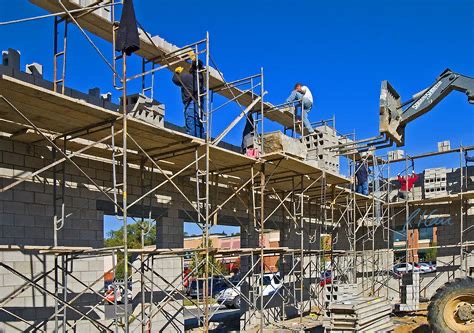
FAQ
1. What is the main difference between mason frame scaffolding and ladder frame scaffolding?
The main difference lies in the frame design and purpose: mason frame scaffolding has horizontal steps for supporting planks or workbenches (not for climbing), while ladder frame scaffolding features integrated rungs specifically for climbing between scaffold levels.
2. Can mason frame scaffolding be used for non-masonry projects?
Yes, mason frame scaffolding can be used for any project requiring a wide, stable platform and high load capacity, such as façade work, painting, or heavy renovations.
3. Are the rungs on mason frame scaffolding safe to climb?
No, the rungs or steps on mason frame scaffolding are not designed for climbing. They are intended to support planks or serve as workbenches. Always use proper access ladders or walk-through frames for climbing.
4. Which scaffolding type is better for narrow or indoor spaces?
Ladder frame scaffolding is generally better for narrow or indoor spaces due to its slimmer profile, built-in ladder access, and lighter weight.
5. How do I ensure safety when using either scaffolding type?
Always follow manufacturer instructions, install guardrails and toe boards, inspect all components before use, and never exceed the specified load capacity. For ladder frames, only climb the rungs from inside the frame; for mason frames, never climb the horizontal steps.













